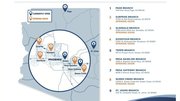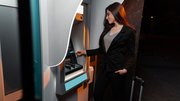News
Check 21: Telling it like it is
Phyllis Myerson, SVP of ECCHO, told attendees at the recent NCR-sponsored ATM Channel Planning Seminar that there are plenty of misconceptions about Check 21 -- many of them perpetuated by the media (gulp).
July 1, 2004
OK, I'll admit it. I was a little nervous when Phyllis Myerson, SVP of the Electronic Check Clearing House Organization (ECCHO) said there were some widespread misconceptions about Check 21 -- many of them perpetuated by the media.
Addressing attendees of last week's ATM Channel Planning Seminar in Washington, D.C., Myerson gave two examples from unnamed publications -- not mine, thank goodness.
According to one, Check 21 "would grant check images the same legal status as paper checks for the purposes of clearing and settlement." The other read: "(Check 21) will allow a collecting bank…to clear their check-based transactions through…check image presentment."
 |
Ann All |
Myerson made me wonder if Ihad accurately reported on Check 21. In a December 2002 article, I wrote: "Essentially, the legislation would allow financial institutions -- by mutual agreement -- to exchange digital images with each other rather than paper to process checks…For those that opt not to receive checks electronically, "substitute checks" could be created using the images."
Whoops, not quite right. FIs already exchange images under reciprocal agreements. The more important part concerns the "substitute checks," which will become a new negotiable instrument when Check 21 goes into effect on Oct. 28.
I did a little better in July of 2003: "(Substitute checks), which will be the same size and carry the same data as original checks, can be exchanged with banks that lack the capability or the desire to receive images. Current law requires banks to physically present and return original checks." Clearing up some Check 21 misconceptions
Myerson told seminar attendees that the Federal Reserve is working on regulations that will detail specifics of how Check 21 will work. She expects to see the regs by the end of July.
While Check 21 will encourage innovation in check collection, it won't mandate image exchange. "It never would have passed" with such a requirement, Myerson said.
FIs must be allowed to introduce image exchange at their own pace, she said. Though not generally known as fast movers on technology, many FIs will likely adopt image exchange sooner rather than later because of the potential cost savings.
Check 21 does say that all FIs must accept substitute checks as the legal equivalent of originals. FIs creating substitutes must make sure they meet all the requirements for legal equivalency -- such as showing both front and back of check, making sure it has a MICR line, etc.
Check 21's biggest benefit: a faster and more efficient collection and return process. FIs will be able to electronically process and transmit images for printing of substitute checks closer to the receiving bank. Branch and ATM deposits could be transmitted to processing centers for printing, which would reduce or even eliminate some transportation costs.
Myerson's presentation was so thorough, I won't even attempt to go into it here. (In part because I don't want anything I write to show up as a future example of inaccuracy.) Much of the information can be found on the Eccho Web site athttp://www.eccho.org.
For more info on Check 21: |
In a room where many of the presenters had multiple academic degrees, Myerson appeared to have the wonk-iest credentials: an MBA in marketing from North Texas State University, an MS in computer science from Pratt Institute and a BS in mathematics from Brooklyn College.
All of the presentations were strong at this NCR-sponsored event, which in its fourth year is becoming a hot ticket among FIs (and others, including 7-Eleven, Wal-Mart, Publix, Cardtronics, eFunds, Metavante, Fiserv and First Data). Here's some of what impressed this editor:
Organize, organize: Tucker Foote, a staffer with the House of Representatives' Committee on Financial Services, tapped credit unions and insurance agents as effective lobbyists -- not because they have a lot of money but because "they are well organized."
He offered three suggestions for influencing legislators: Find a member or members interested in the cause -- the more, the better; get the blessing of the chairman -- in this case, Rep. Michael Oxley (R-Ohio); and adopt a bipartisan approach. "You can't get it out of committee on a party line approach and expect it to go anywhere," he said.
National vs. local: Addressing questions about whether the federal government may consider regulating independently owned and operated ATMs, Foote said the Financial Services Committee prefers to step in only when issues reach a national scope. "You have to be careful not to over-regulate. You don't want to use a bulldozer to do your gardening." An example of recent regulation from the committee is the Fair and Accurate Credit Transaction Act, which will help combat identification theft.
Under new management: Kevin Carroll, director of ATM Product Management for First Data Corp., stressed that it's important to be proactive with Windows-based ATMs. Deployers should know which systems and servers are linked and can communicate with the ATM, which version of Windows is on each machine and other details. The good news: "Asset management is easier in a Windows world," he said.
Security as differentiator: Wayne Malone, Citibank's VP of Distribution and Deposits, said that market research showed that consumers considered account security "a highly differentiating" feature for FIs. So the bank created its ID Theft Solutions program, to promote some of its anti-fraud initiatives, such as proprietary software which issues early alerts when credit or debit card fraud is suspected. A new feature: A "toolkit" to help fraud victims file police reports, place alerts with creditors and more - available to both customers and non-customers.
Humor sells: Malone showed clips from the marketing campaign with fraud victims speaking in the unlikely voices of the thieves who stole their account information - for instance, a petite Asian woman appears to channel a hairy guy who uses her card info to invest in some waxing sessions. Funny, but they communicate a serious message very effectively.
More details on bonus tax depreciation: |
Citi also promotes fraud awareness via a variety of other media - with decals on floors and trash cans near ATMs reading "a trash can is a bad place for your financial information," for example.
Less paper, less theft: Citibank created its Access Account, a "checkless" checking account, after its research showed that "a paper trail is a big part of identification theft," Malone said. Again, it promotes the account with clever campaigns that appear to resonate with consumers. One example: a billboard that appears to have been run through a shredder that reads: "less paper means less to shred."
While FIs have had limited success in moving consumers from paper to electronic transactions, playing on their fears -- in a clever and non-threatening way, like Citi is doing -- just may work.
The taxman cometh: George Manousos, a taxation specialist with the Department of the Treasury, said that a bonus depreciation provision that allows for a first year tax depreciation bonus of 50 percent for eligible purchases -- like new ATMs or upgrades -- will expire Dec. 31, 2004. The provision was created in 2001 to help revive a slumping economy. Congress may or may not opt to extend it, Manousos said. More details are available athttp://www.do.treas.gov.
Know-it-alls -- or not: William McCracken, chief executive of Synergistics Research, compared responses about ATM usage from consumers recently queried by Synergistics and from FIs who filled out surveys at NCR's request. The discrepancies were interesting. For instance, the percentage of consumers using ATMs has remained relatively flat for nearly a decade, McCracken said, at 58 percent. FIs guessed it was 72 percent. Similarly, while 25 percent of consumers have never used an ATM, FIs guessed it was just 18 percent.
% of ATM users FIs guessed: 72% Consumers said: 58% Source: Synergistics Research |
Cash still king: FIs guessed that 75 percent of ATM visits involved cash withdrawals. The true number is higher, at 89 percent. This is troubling, McCracken said, because credit, debit and cash back at the point-of-sale are eroding the ATM's "core value" as a cash dispenser.
Watch out for debit: In the period between 1997 and 2003, debit transactions grew 271 percent; during the same period, ATM transactions declined 1.5 percent. Of the four in 10 debit card users who obtain cash back, almost three-quarters say they visit ATMs less often, McCracken said. Four in 10 say they visit branches less. "The ATM is being hit hardest" by debit.
Let's get personal: The ATM "is not going to win back debit users with cash withdrawal," McCracken said. "It's going to have to be an issue of what services the ATM can offer that debit cannot."
Personalization is a feature that seemed to resonate with consumers in Synergistics' survey. They expressed interest in: automatic balance information, 68 percent; ability to get specific cash amounts, 58 percent; automatic language selection, 51 percent; automatic list of previous five transactions, 49 percent; pre-selected withdrawal amount, 43 percent; alerts of CDs about to expire, 38 percent; alerts of loan payments due, 36 percent; pertinent information on investment products, 20 percent.
Driving deposits: Making deposits easier and more convenient also "may be a shot in the arm that ATMs need," McCracken said. Consumers surveyed were interested in: ability to split deposit among different accounts, 51 percent; having the amount printed on the receipt, 48 percent; ability to withdraw funds immediately, 47 percent; image of check printed on receipt, 41 percent; seeing image of check on ATM screen, 38 percent; and deposit without envelope, 32 percent.
Several of these features will become more likely in a post-Check 21 world, McCracken said.
Young blood: Sixty-three percent of consumers age 18 to 34 showed a preference for an ATM with advanced features, while only 30 percent said they'd prefer a basic ATM. Among the other age categories, the preference was less obvious. Interestingly, the same 18 to 34 age category accounted for the largest percentage calling themselves "ex-users" of ATMs, a whopping 69 percent. "That's a group you don't want to lose," McCracken said.














